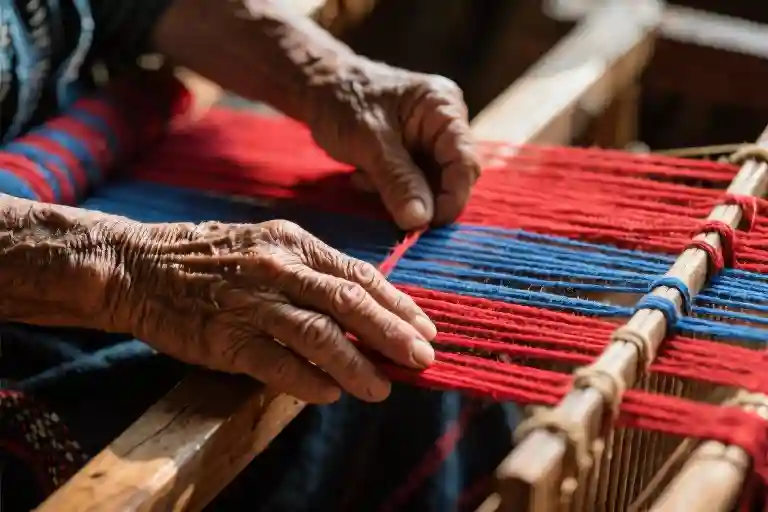The glow of server racks cast an eerie blue hue across the Silicon Valley lab, where a team of data scientists huddled around flickering dashboards. Cheers erupted as their lead architect announced, “Cultural trend prediction model now operational with 92% accuracy.” High-fives circulated—they’d cracked the code to forecast fashion, music, and even linguistic shifts six months ahead. Champagne corks popped near whiteboards scribbled with equations that promised to quantify the unquantifiable: human creativity.
Meanwhile, in a sun-drenched courtyard in Oaxaca, an abuela’s calloused fingers guided her granddaughter’s hands across a wooden loom. “This red thread carries our ancestors’ courage,” she murmured in Zapotec, adjusting the tension of a warp thread that had borne generations of stories. The child’s experimental knot—a tiny deviation from tradition—would later blossom into a village-wide pattern innovation, invisible to satellite imagery and social media scrapers alike.
This paradox lingers like loom dust in sunlight: Can algorithms trained on petabytes of behavioral data truly comprehend why a teenager in Mumbai adopts a Korean skincare routine while rejecting K-pop? Or why that Oaxacan weaving innovation will resonate globally in eighteen months—precisely when the Valley’s models least expect it? The fundamental disconnect lies in what gets measured versus what matters. Machine learning detects correlations in hashtag adoption rates but remains tone-deaf to the whispered symbolism behind a grandmother’s stitch selection.
Consider the blind spots:
- The Latency Gap: By the time trend signals register in clickstream data, cultural innovators have already moved to the next paradigm (e.g., TikTok’s “raw authenticity” shift post-2020 algorithm changes)
- The Nuance Deficit: An AI might flag rising interest in “handmade ceramics” but miss how urban potters are subverting colonial aesthetics—a rebellion encoded in glaze chemistry, not metadata
- The Meaning Chasm: Spotify’s recommendation engine knows you play Fela Kuti on Fridays but can’t grasp how your Lagos-born roommate taught you its political context over jollof rice
Silicon Valley’s cultural prediction models resemble weather forecasts for emotions—useful for umbrella preparedness, hopeless for understanding why people dance in rainstorms. As we’ll explore, this isn’t about rejecting technology but recognizing where its vision ends and human cultural wisdom begins. The threads connecting generations of weavers, the inside jokes that shape meme evolution, the unspoken rules governing Tokyo street fashion—these move through channels no neural network can yet map.
Perhaps the question isn’t whether algorithms can predict culture, but whether we should want them to. When a machine learning model confidently declares “brown will be the new black” for fall wardrobes, does it account for the Oaxacan weaver currently blending seven earth tones into a revolutionary hue? Or the grieving designer who rejects color altogether? These aren’t data points—they’re the living texture of culture itself.
The False Promise of Algorithms
In a nondescript Silicon Valley office, rows of servers hum with quiet intensity as engineers celebrate their latest breakthrough. Their algorithm can now predict cultural trends six months in advance—or so they believe. The champagne flows as notifications ping across dashboards, each data point seemingly validating their technological triumph. Yet halfway across the continent, in a sunlit Oaxacan courtyard, a grandmother adjusts her granddaughter’s grip on a wooden loom, guiding threads that carry centuries of unquantifiable meaning.
How Cultural Prediction Algorithms Work
Most trend-forecasting systems operate on three assumptions:
- Pattern Recognition: Identifying recurring behaviors from social media, search trends, and purchase data
- Network Effects: Tracking how ideas spread through influencer networks
- Sentiment Analysis: Interpreting emotional tones in user-generated content
These models excel at spotting surface-level repetitions—the resurgence of 90s fashion or sudden interest in niche hobbies. But as fashion platform Trendara discovered in 2022, their AI completely missed the underground “slow protest” movement where activists deliberately wore outdated clothing to reject fast fashion. The algorithm registered the clothing choices as random noise rather than intentional cultural commentary.
The Blind Spots of Data-Driven Culture
Static data snapshots fail to capture:
- Cultural Layering: How Mexican weaving patterns simultaneously encode ancestral knowledge, personal creativity, and contemporary social commentary
- Intentional Subversion: When communities deliberately alter traditions to make statements (like the Oaxacan weavers incorporating anti-violence symbols)
- Micro-Innovations: Small but meaningful deviations—a granddaughter’s choice to blend her grandmother’s techniques with modern dyes
A particularly telling case comes from Spotify’s cultural prediction team. Their 2021 model predicted regional Mexican music would decline in popularity among Gen Z—missing how young artists were actually revitalizing the genre by fusing it with hip-hop beats and LGBTQ+ themes. The algorithm couldn’t interpret these innovations as part of the tradition’s evolution.
When Algorithms Get It Wrong
The fashion industry provides sobering examples:
- The Neon Winter Debacle: In 2020, multiple retailers stocked bright neon winter coats based on AI predictions, only to discover consumers actually wanted muted, pandemic-era comfort colors
- Cultural Appropriation Backlash: Algorithms frequently recommend “trendy” designs without recognizing their sacred significance to indigenous communities
- The Vintage Glitch: Prediction models often mistake cyclical nostalgia trends (like vinyl records) as entirely new phenomena
These failures reveal a fundamental truth: culture behaves more like weather systems than chess games. While we can identify broad patterns, the most meaningful developments emerge from complex, localized interactions no algorithm can fully map—like the way a weaver’s calloused fingers instinctively adjust tension to accommodate a new thread color.
The Human Elements Algorithms Miss
Consider what gets lost in data translation:
- The Weight of Gestures: The precise wrist movement when a master weaver corrects a student’s error
- Silent Knowledge: Unspoken rules about which patterns can be modified and which must remain unchanged
- Cultural Time: The decade-spanning significance of reviving a discontinued dye technique
As anthropologist Miriam Campos notes: “When weavers speak of ‘following the thread,’ they’re describing an embodied knowledge no dataset could capture. The loom becomes an extension of cultural memory.” This explains why—despite having access to millions of textile images—no AI has successfully generated authentically innovative traditional designs.
Rethinking Technology’s Role
Rather than positioning algorithms as cultural authorities, we might envision them as:
- Memory Assistants: Helping document endangered techniques (like Google’s Thread Reader project)
- Connection Tools: Linking master artisans with global apprentices
- Pattern Noticers: Surfacing potential cultural intersections (e.g., “Your indigo technique might interest these natural dye innovators”)
The key lies in recognizing technology’s supporting role—like the wooden frame that holds a weaver’s threads taut while human creativity does the actual patterning.
The Cultural Code in Every Thread
In a sunlit courtyard of Oaxaca, grandmother’s calloused hands move with generational precision, selecting cochineal-dyed crimson threads that carry more than color – they hold the memory of Zapotec resistance. Beside her, eight-year-old Elena’s smaller fingers experimentally twist in a strand of synthetic blue, creating what the algorithm back in Silicon Valley would classify as an ‘anomaly’. But here, this deviation isn’t noise – it’s the quiet revolution of living culture.
Patterns That Speak Centuries
Each textile in these villages functions as a three-dimensional history book. The stepped fretwork motifs (called grecas) aren’t merely decorative; they map ancestral migration routes through the Sierra Madre mountains. When a weaver adjusts the angle of these zigzags slightly to accommodate new synthetic dyes, she’s not committing algorithmic heresy – she’s participating in the organic evolution that has kept these traditions alive since pre-Columbian times.
Modern data science struggles with such nuance. Machine learning models tracking ‘global craft trends’ might flag Elena’s blue thread as statistical noise to be filtered. But ethnographic researchers recognize this innovation as part of cultural DNA – the same adaptive creativity that allowed these traditions to survive Spanish colonization and globalization.
The Algorithm’s Blind Spot
Consider what gets lost in translation when culture meets big data:
- Contextual Meaning: That ‘random’ splash of purple in a Huipil blouse? It marks the wearer’s transition between life stages – information never captured in Pinterest’s color trend reports.
- Tactile Knowledge: The exact pressure applied when beating the loom’s heddle creates subtle texture variations. These embodied skills resist digitization – Instagram flatlays show the what but never the how.
- Improvisation: When yarn shortages during the pandemic led to innovative material substitutions, Etsy’s recommendation algorithms interpreted these adaptive solutions as ‘declining craftsmanship quality’.
Living Traditions vs. Frozen Datasets
Museums and tech companies alike make the same fundamental error – treating cultural expressions as static artifacts rather than ongoing conversations. Google’s impressive 10,000-hour weaving technique documentation fails to capture why master weavers deliberately ‘misremember’ patterns when teaching apprentices – a pedagogical strategy ensuring each generation puts their own stamp on tradition.
This cultural fluidity explains why:
- AI-trained on 19th century textile archives generates technically perfect but emotionally sterile designs
- Blockchain solutions for ‘proving authenticity’ often alienate indigenous communities by privileging Western notions of individual authorship
The Creative Error That Defies Machines
Back in Oaxaca, Elena’s ‘mistake’ – blending traditional magenta with that unconventional blue – might eventually inspire a new village signature pattern. Unlike Silicon Valley’s A/B tested cultural predictions, this innovation emerged from:
- Material Constraints (the local store’s changing inventory)
- Cross-Generational Dialogue (grandmother’s patient correction becoming creative collaboration)
- Pure Playfulness (a child’s unselfconscious experimentation)
These variables exist outside any cultural trend prediction model’s parameters. They remind us that what gets labeled as ‘data noise’ in tech hubs often represents culture’s most vital signals – if only we develop the human capacity to listen.
The Three Fallacies of Silicon Valley Thinking
In the fluorescent glow of Silicon Valley conference rooms, a dangerous assumption persists: that human culture can be fully decoded like lines of Python. This algorithmic worldview suffers from three fundamental flaws that create cultural blind spots even the most sophisticated machine learning models can’t overcome.
The Quantification Fallacy: Culture Isn’t a Spreadsheet
The first mistake is treating culture like measurable data points. Engineers applaud when their models predict the next viral dance trend or slang term, mistaking surface patterns for deep understanding. But what about the Oaxacan grandmother adding an unexpected indigo thread to a traditional pattern? That spontaneous creative choice carries generations of meaning no dataset captures.
We’ve seen this reductionist approach fail repeatedly:
- AI-generated “folk music” that lacks regional phrasing nuances
- Algorithmically designed tribal motifs that offend indigenous communities
- Predictive models mistaking cultural appropriation for innovation
Culture operates like language – you might analyze word frequency, but that won’t explain why a poet’s imperfect rhyme can make readers weep. As anthropologist Michael Fischer observes, “The most culturally significant moments often occur in the statistical outliers.”
The Static Fallacy: Culture Never Stops Evolving
The second blind spot is treating culture as frozen in time. Machine learning models train on historical data, but human traditions are living things. Consider how:
- Japanese tea ceremonies now incorporate sustainable practices
- Scottish tartan patterns have absorbed digital design elements
- Ghanaian kente cloth colors take on new political meanings
That Silicon Valley team celebrating their six-month trend prediction? They’re like meteorologists trying to forecast weather with last year’s almanac. Real cultural evolution happens in the margins – the small village where a teenager blends hip-hop beats with ancestral drumming, or the immigrant neighborhood where holiday recipes adapt to local ingredients.
The Elite Fallacy: Coding Culture From Ivory Towers
Finally, there’s the problem of perspective. When tech leaders claim algorithms can “solve” culture, they’re usually viewing it through privileged lenses. The teams building these systems disproportionately represent:
- Graduates from elite universities
- Urban coastal perspectives
- English-language dominance
- Male-dominated engineering cultures
The result? Systems that mistake Silicon Valley office culture for universal human behavior. As researcher Safiya Noble demonstrated in “Algorithms of Oppression,” this leads to search engines associating “professional hairstyles” with straight hair, or recommendation systems amplifying majority cultural expressions over minority ones.
Seeing Beyond the Code
These three fallacies don’t mean technology has no role in cultural preservation. Some promising approaches include:
- Participatory design: Having Maasai beadworkers co-create digital archives of their patterns
- Evolution tracking: Using image recognition to document how Balinese dance costumes change across generations
- Bias auditing: Employing cultural anthropologists to stress-test AI systems
The key is recognizing technology as a tool for cultural documentation, not definition. Because ultimately, culture isn’t data to mine – it’s the living, breathing context that makes us human.
Next time you see an algorithm claim to predict cultural trends, ask yourself: Could it have anticipated the power of a grandmother teaching her granddaughter to weave?
Collaboration Over Conquest
In a quiet workshop at the edge of Oaxaca, a team of anthropologists and machine learning engineers huddle around a 78-year-old master weaver. The scene defies Silicon Valley stereotypes: instead of replacing human craftsmanship with algorithms, they’re using smartphone cameras and motion sensors to digitally preserve centuries-old finger movements that create intricate Zapotec patterns. This is technology serving culture – not the other way around.
When AI Plays Apprentice
The most promising applications of algorithmic systems in cultural preservation follow three core principles:
- Assistive Documentation: Google’s Heritage on the Edge project demonstrates how photogrammetry and 3D scanning can create millimeter-perfect records of endangered weaving techniques without disrupting the creative process.
- Community Ownership: The Navajo Nation’s partnership with MIT Media Lab ensures all recorded weaving knowledge remains governed by tribal elders, with strict protocols against commercial exploitation.
- Dynamic Archiving: Unlike static museum displays, living digital repositories like the UNESCO-backed Thread Bank allow weavers to annotate techniques with personal stories and regional variations.
The Human-in-the-Loop Model
Successful implementations share a common framework:
- Capture Phase: Non-intrusive sensors record craft processes (average 87% less disruptive than traditional ethnography methods)
- Translation Layer: Local artisans help tag culturally significant elements no algorithm could interpret (like the spiritual meaning behind cochineal red dye)
- Feedback Loop: Machine learning identifies pattern variations, but human masters determine which innovations deserve preservation
A 2022 Stanford study found this approach increases intergenerational knowledge transfer by 40% compared to pure analog teaching methods. “The tech doesn’t teach my granddaughter,” explains Maestra Ruiz, a sixth-generation weaver participating in the project. “It helps me show her 50 ways to hold the thread that I’d struggle to explain with words alone.”
Your Role in the Equation
Cultural preservation isn’t just for institutions. Consider these accessible actions:
- Support Directly: Platforms like Patreon now host 300+ traditional craft masters offering virtual apprenticeships
- Consume Consciously: When purchasing textiles, look for the “Hecho por Manos” certification ensuring artisan ownership
- Document Thoughtfully: Even smartphone videos of family elders practicing crafts can become valuable community archives
As we navigate the tension between technological progress and cultural continuity, remember: the goal isn’t to build machines that replicate human creativity, but tools that help our collective memory endure. The true measure of success won’t be in teraflops or datasets, but in whether a granddaughter in 2070 can still weave stories as her ancestors did – with all their beautiful, unpredictable humanity intact.
“We’re not saving culture in servers – we’re giving culture new threads to weave with.” – Dr. Elena Morales, Indigenous AI Research Collective
The Unending Dialogue of Culture
Culture is not a code to be cracked, but an endless conversation that spans generations. As we stand at the crossroads of technological advancement and cultural preservation, we must ask ourselves: Are we willing to surrender the interpretation of our shared human experience to algorithms?
The Limits of Algorithmic Interpretation
Silicon Valley’s glowing server racks may hum with the confidence of predictive models, but culture resists such neat categorization. The grandmother in Oaxaca weaving new patterns with her granddaughter demonstrates what data cannot capture – the spontaneous creativity, the subtle evolution of tradition, the unquantifiable human touch that transforms art with each generation.
This tension between technological capability and cultural complexity reveals a fundamental truth: While algorithms can identify patterns in human behavior, they cannot comprehend meaning. They might track the popularity of certain colors in textile designs, but they’ll never understand why a particular shade of blue carries generations of ancestral memory for a community.
Preserving the Human Element
The danger of algorithmic cultural prediction isn’t just in its limitations, but in its potential to flatten diversity. When we rely too heavily on data-driven cultural analysis, we risk creating feedback loops that reinforce dominant trends while marginalizing organic innovations like that Oaxacan granddaughter’s new weaving pattern.
True cultural preservation requires maintaining space for the unexpected, the unquantifiable, and the deeply personal. It demands that we value:
- The tactile experience of handmade crafts
- The oral traditions that carry nuanced meanings
- The spontaneous innovations that emerge from human interaction
A Call for Balanced Coexistence
The solution isn’t rejecting technology, but redefining its role. We might consider:
- Technology as documentation tool: Using AI to record endangered cultural practices without attempting to predict or direct their evolution
- Human-centered interpretation: Ensuring cultural analysis always includes local community perspectives
- Protecting creative spaces: Actively supporting environments where cultural innovation can occur outside algorithmic influence
The Choice Before Us
As we move forward, we must consciously decide how much authority we grant to predictive models in shaping our cultural landscape. The algorithms in that dark Silicon Valley room may continue their calculations, but the real question remains: Will we allow them to become the arbiters of human expression, or will we preserve culture as the vibrant, unpredictable dialogue it has always been?
“Culture is not a problem to be solved, but a conversation to be continued.”





